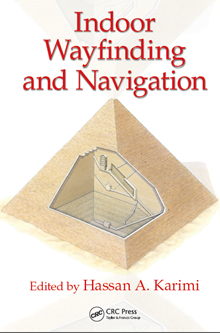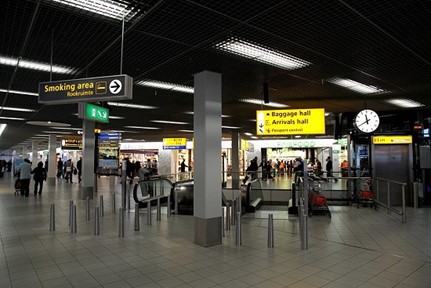Tag: Indoor Navigation
Past, Present, and Future of Simultaneous Localization and Mapping: Toward the Robust-Perception Age
Simultaneous localization and mapping (SLAM) consists in the concurrent construction of a model of the environment (the map), and the estimation of the state of the robot moving within it. The SLAM community has made astonishing progress over the last …
经典图书分享:《Indoor Wayfinding and Navigation》
经典图书分享:《Indoor Wayfinding and Navigation》

《Indoor Wayfinding and Navigation》,这本书由美国匹兹堡大学(University of Pittsburgh)的 Hassan Karimi教授主编,Carnegie Mellon University、University of Pisstburgh、German Aerospace Center (DLR)、European Organization for Nuclear Research、Universidade do Minho、RWTH Aachen University等机构的多位学者联合编撰而成。
Features
-
Combines in one book state-of-the-art techniques and technologies for indoor
室内定位与建模相关硕士学位研究课题
室内定位与建模相关硕士学位研究课题
代尔夫特大学 三维地理信息实验室
Walter Yu 译
1、基于室内体素化模型(Voxelized Model)的3D路径查询
3D Path-finding in a voxelized model of indoor environments
体素化(Voxelisation)是一种表达3D格网的方法。基于Voxel的模型以一种离散的方式描述了室内空间。与B-Rep(Boundary Representation)方式不同,Voxel表达方式能够支持更好地分析空的空间(Empty Space)。因此,基于体素化(Voxelized)的建筑模型很适合3D室内导航。目前的路径查询方法中大多是通过构建室内环境的2D或2.5D模型(如楼层平面图或室内表面模型)来实现的。
然而,这些方法不能处理这样一些情况,如从障碍物(如桌子)上面或下面通过、在特定高度移动(如飞行)、避开悬挂物等。这项研究的目的是开发一种基于Voxel的路径查询方法,其中包括特殊的3D路径,即满足不同模式(如正常情况、应急情况)下的不同需求(如在地面上或者在空中)。需要研究的问题包括:组织Voxels的数据结构、所需要的语义信息、支持不同模式的路径查询算法。
2、FaciliDat:面向设施管理的3D室内模型及数据库模式
FaciliDat: 3D Indoor model and a database schema for facility management
…
面向路径查询的室内语义建模
面向路径查询的室内语义建模
Indoor Semantic Modeling to Support Path-Finding
Sisi Zlatanova、Liu Liu 等编写
Walter Yu 译
1、室内导航
导航与位置服务是GIS领域发展很快的应用之一。目前,室内导航或室内外无缝导航得到人们的广泛关注。由于人们绝大部分时间都处在室内空间(如图1所示),当人们在复杂的大型室内环境时往往需要类似室外导航的许多应用服务。


图1 复杂室内空间示例
2、存在问题
在室内数据获取、室内建模和用户个性化路径规划等方法存在许多挑战。虽然已经有一些不同类型的3D几何建筑模型以及面向不同目的的语义模型(如CityGML、BIM),但它们缺乏支持大量不同类型用户室内导航服务的有效信息。此外,由于导航网络和导航语义的差异,导致有些情况下室外路径规划方法难以完全应用在室内环境中。
3、室内语义建模研究
Liu Liu 博士和Sisi Zlatanova教授研究了面向室内导航的语义建模,特别是针对复杂室内环境。他们提出了一种语义建模方法,叫做Indoor Navigation Space Model (INSM),与任意指定类型的建筑物划分密切相关,如图2所示。它不仅定义了支持导航的所有需要的建筑要素,而且与建筑组件(如房间、门、楼梯灯)的几何进行关联。
…
Pedestrian Indoor Navigation In the Institute for Real-Time Computer Systems, TU-Munich, Germany
Pedestrian Indoor Navigation In the Institute for Real-Time Computer Systems,
TU-Munich, Germany
As the importance of location-based services grows, the accuracy and availability of location becomes a crucial issue for the success of such services. While outdoor localization via …
i-locate:Indoor/outdoor location and asset management through open geodata
Recent studies have highlighted that, on average, we spend approximately 90% of our time indoors, often in unfamiliar environments. Being able to seamlessly locate people or objects within indoor AND outdoor spaces could enable a number of new Location-Based Services
About
Brain Inspired Navigation Blog
New discovery worth spreading on brain-inspired navigation in neurorobotics and neuroscience
Recent Posts
- How environmental novelty modulate rapid cortical plasticity during navigation?
- How the Hippocampal Cognitive Map Supports Flexible Navigation?
- How the geometric structure and underlying circuit organization of hippocampal population dynamics facilitate both memory discrimination and generalization, enabling efficient and flexible learning?
- How hippocampal representations drift in stable multisensory environments?
- How visual objects refine head direction coding?
Tags
Categories
- 3D Movement
- 3D Navigation
- 3D Path Integration
- 3D Perception
- 3D SLAM
- 3D Spatial Representation
- AI Navigation
- Bio-Inspired Robotics
- Brain Inspired Localization
- Brain-Inspired Navigation
- Cognitive Map
- Cognitive Navigation
- Episodic Memory
- Excerpt Notes
- Flying Vehicle Navigation
- Goal Representation
- Insect Navigation
- Learning to Navigate
- Memory
- Neural Basis of Navigation
- Path Integration
- Path Planning
- Project
- Research Tips
- Robotic Vision
- Self-Flying Vehicles
- Semantic Memory
- Spatial Cognition
- Spatial Cognitive Computing
- Spatial Coordinate System
- Spatial Learning
- Spatial Memory
- Spatial Resoning
- Time
- Unclassified
- Visual Cortex
- Visual Cue Cells
Links
- Laboratory of Nachum Ulanovsky
- Jeffery Lab
- BatLab
- The NeuroBat Lab
- Taube Lab
- Laurens Group
- Romani Lab
- Moser Group
- O’Keefe Group
- DoellerLab
- MilfordRobotics Group
- The Space and Memory group
- Angelaki Lab
- Spatial Cognition Lab
- McNaughton Lab
- Conradt Group
- The Fiete Lab
- The Cacucci Lab
- The Burak Lab
- Knierim Lab
- Clark Spatial Navigation & Memory Lab
- Computational Memory Lab
- The Dombeck Lab
- Zugaro Lab
- Insect Robotics Group
- The Nagel Lab
- Basu Lab
- Spatial Perception and Memory lab
- The Neuroecology lab
- The Nagel Lab
- Neural Modeling and Interface Lab
- Memory and Navigation Circuits Group
- Neural Circuits and Memory Lab
- The lab of Arseny Finkelstein
- The Epstein Lab
- The Theoretical Neuroscience Lab
- Gu Lab (Spatial Navigation and Memory)
- Fisher Lab (Neural Circuits for Navigation)
- The Alexander Lab (Spatial Cognition and Memory)
- Harvey Lab (Neural Circuits for Navigation)
- Buzsáki Lab
- Brain Computation & Behavior Lab
- ……